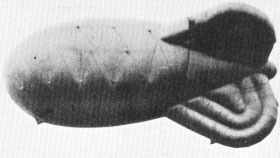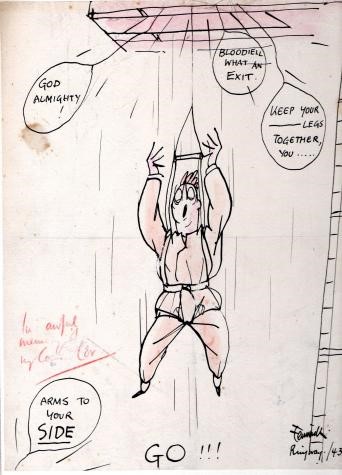 Click
for Site Directory
Click
for Site Directory
The Parachute Regiment and Barrage Balloons
Following the humiliation of Dunkirk, Churchill with his remarkable vision, optimism and courage had seen in the German use of parachute troops at Rotterdam a weapon of
tremendous potential power that Britain would need to adapt and employ for future military invasions.
Parachuting had been, pre-war, a form of entertainment that was often encountered at travelling fairs and circuses where a tethered balloon would rise to some considerable height and a man or woman would leap from the balloon and deploy the chute while the watching and paying crowd watched in a mixture fascinated horror and excitement. Sir Alan Cobbam's Air Circus being just one that thrilled people with parachutists.
It had become a useful tool for aircrew to wear when airborne and in the event of the aircraft becoming un-flyable the order would be given to "bail out". The crew would exit and deploy chutes. Since Irwin were the parachute suppliers they formed the Caterpillar Club where anyone who had their life saved by using an Irwin Parachute was enrolled into the club, given a certificate and a caterpillar badge. The caterpillar was chosen because of the link between silk production and the silkworm.
Now it was to be used to allow mass dropping of armed troops and supplies when Britain returned to the continent. Churchill ordered that a force of five thousand soldiers be raised on the same lines as that of Commandos.
In June 1940 an Air Ministry conference was held to discuss the air requirements that would be needed to produce these parachute troops. By the end of June Manchester Corporation's civil airport at Ringway was chosen as the home of this new and untrained unit. The choice was decided on a requirement to keep the training away from operational areas. The home of R.A.F. parachuting was R.A.F. Henlow, here aircrew would be given the opportunity to jump from an ancient bi-plane using a 28-foot instead of the 24-foot Irving parachute. They were also trained in the use of a reserve parachute.
This was a combined services establishment and was called "The Central Landing School", it was run by the Army and the Royal Air Force. The RAF dealing with all the developing and training of the air side and the Army had responsibility for the military men. One can imagine that the viewpoints of these arms of the services differed in so many ways and was not always ideal ground for getting things done in a smooth way.
This new unit was to be produced from scratch, there were no military manuals and the special parachutes needed existed only in the minds of a few people. Germany however was 6 years ahead of Britain from a Parachute Troop viewpoint. In terms of rapid troop deployment we still saw the seagoing ship as our normal yardstick. This was probably because of the fact that we were an island race. The Germans had worked out that parachute troops were one of the fastest ways to deploy a attacking or even defending force on the ground. We had missed an opportunity of great value.
On the 9th July 1940 the first men from "B" and "C" troops of No.2 Commando arrived at Ringway. Urgent missives were sent to Garrison Commanders and Local Defence Groups in the Knutsford area to inform them that they may well see friendly parachutists training in their locality and it was requested that no one should shoot at them! On the morning of 13th July 1940 over Tatton Park white puffs appeared in the sky falling from aircraft. Initially these were weighted dummies but soon real live men were landing on the ground.
A Whitley aircraft was specially adapted with a hole in the floor and used for parachute drops. The Whitley could drop 10 men in 10 second and this meant that they were dispersed over some 500 yards of ground.
One of the basic requirements was that descending parachute troops presented a vulnerable target to any defending enemy on the ground and they needed to be
dropped from a low height so that their time of descent was as short as possible and reduce their exposure to enemy ground fire.
It was a risky business and injuries were caused to a few men who made bad landings. On the 25th July 1940 after 135 successful drops and landing by the men did disaster strike.
T/175282Driver Ralph Evans of the Royal Army Service Corps and No. 2 Commando was unfortunate in that his parachute simply failed to open. His untimely death caused a halt to parachute work until the accident was investigated. After two weeks a redesigned packing bag was produced in which the rigging lines were withdrawn before the silk canopy, instead of afterwards.
Training recommenced on the 14th August 1940. On the 27th August 1940 a second death, due to parachute failure, happened to Trooper Stanley Watts of the Household Cavalry.
By the 21st September 1940, 21 officers and 321 men had been accepted for training. 30 men refused to jump, these were known by the name of "jibbers", 20 were injured on landing causing them to be classed as medically unfit. This was a wastage of some 15% of high calibre men.
In October 1940 an additional glider section was added to the Central Landing School, following some experimentation of a Special Duty Flight with gliders at Christchurch. A further experimental unit was set up to try and solve tactical and experimental issues that were being found to challenge the progress of the work.
This meant a change of name to "The Central Landing Establishment".
On the 18th November 1940, 4078193 Corporal Hugh John Carter, 4th Battalion Monmouthshire Regiment, the son of James and Florence Emily Carter, of Newport, had a parachute that failed to open because of a poorly designed snap hook. This was redesigned as a matter of urgency. By the end of 1940 some 2,000 descents had been made
In the Great War, Observation Balloon Officers used parachutes, known as "Guardian Angels", to abandon the basket of their Observation Balloon when it was being attacked by German aircraft. There were fatalities with this system as well.
Observation Balloon with parachute in "Acorn" container on RHS
Observation Balloon with parachute in "Acorn" container on RHS
The intriguing thing about the idea of using balloons to train parachutists was that one balloon could drop as many men in one hour as three Whitley aircraft in the same time. Jumping from a balloon reduced the tendency of the human body to somersault or twist.
Using co-operation with Balloon Command a prototype barrage balloon with a car suspended underneath was delivered in December 1940.
At Tatton Park the first balloon was installed in April 1941 and was not popular among the men. After 3 months no more that 100 jumps had taken place. The car suspended below was a scary place and the floor consisted mainly of a large hole around which men clung to whatever they could to prevent slipping through the hole.
Men hated the harsh monotonous grinding noise of the winch and the total silence when enough cable was paid out. A feeling of gross instability encompassed every man as the balloon yawed this way and that, causing the car to tilt at a frightening angle. There was a huge psychological barrier to overcome and it was realised that jumping from a balloon was a great way to introduce man to parachuting in large numbers. The balloon remained more or less in one place and meant a loud speaker could be utilised to give second by second instructions to the descending man. Ultimately some 6,000 descents per month were made from balloons.
"Bessie" the balloon was handled by crews from Balloon Command who maintained the winches and the balloons with their usual expert skill both by day and for night jumping.
One R.A.F. padre who jumped for the first time confessed that his as he descended his lifetime of trust in God had been replaced during the 5 seconds it took for the parachute to open by a W.A.A.F. parachute packer!
The decision was made to provide pre-jumping training from a balloon at Hardwick Camp from 1st November 1941. Twelve days later 1,773 parachute descents from a balloon had taken place with no deaths resulting. Ian Fenwick produced a memorable cartoon of a parachutist falling with the parachute not yet opened with the comment "Hanging about waiting for opening time"!
The Parachute Regiment was now ready for formation and balloons were used for many years during and post-war to speed up the training.
Eventually after much experimentation the Mark XI Kite Balloon was made. It was 83 feet 6 inches long and 33 feet 6 inches wide. The volume was 45,000 cubic feet of hydrogen. The design was much the same as the normal balloon, but a few modifications were added in. The rip panel was designed so that the rip panel was opened by means of a rip cord which was attached to the balloon by three snatch clips and during parachuting it was secured at its lower end to the centre starboard tubular bar on the outside of the balloon car. This meant the rip cord could be reached with ease from inside the balloon car. To prevent accidental operation of the rip panel some slack was allowed in the cord and a force of 15 to 20 lb was needed to detach each snatch clip in turn.
If the cable parted the instructor was to ensure that all other occupants of the car were ordered to jump. Once only the instructor was left in the car he made sure he was at a safe height to parachute and would lean over and pull the red rip cord using four sharp tugs to ensure full opening of the rip panel, which was designed to cut the balloon fabric using a fine wire, not unlike cheese wire The instructor should then jump and the balloon would deflate and after
around 4 minutes it would reach the ground however the prevailing winds may mean that it would often land some miles away.

The balloon had a life of only 200 days and was costing £1040 to make. Inflation cost £30 to £40 and required some 100 to 110 gas cylinders to do this. Each cylinder held 350-400 cubic feet of gas.
When inflated the balloon had a net lift of 1800lb but when the weight of the car was taken into account (465 lbs) it reduced the lift to 1200 lbs.
When night parachuting was carried out the balloon had to carry two white lights on the balloon car, one white light and one red light at the top of the flying cable and a similar sequence every 600 foot.
In addition, a group of flashing lights one green and two red fixed on the winch in the form of a triangle to indicate the angle of the flying cable and the position of the object to which the balloon was moored on their ground.
Did you or any of your comrades fly these parachute balloons at all?